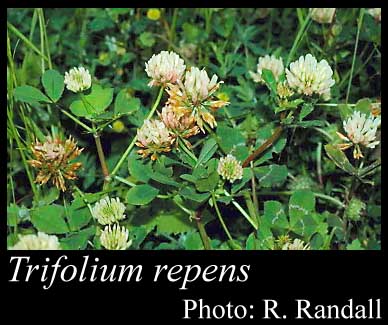- Reference
- Sp.Pl. [Linnaeus] 2:767 (1753)
- Conservation Code
- Not threatened
- Naturalised Status
- Alien to Western Australia
- Name Status
- Current
Prostrate rhizomatous, annual or perennial, herb, to 0.15 m high, to 1 m wide. Fl. white, Jul to Nov. Grey sand, black sandy clay, peaty sand. Wetlands, road verges, track edges, pastures & gardens.







Distribution
- IBRA Regions
- Avon Wheatbelt, Jarrah Forest, Swan Coastal Plain, Warren.
- IBRA Subregions
- Katanning, Northern Jarrah Forest, Perth, Southern Jarrah Forest, Warren.
- IMCRA Regions
- WA South Coast.
- Local Government Areas (LGAs)
- Albany, Augusta Margaret River, Bayswater, Busselton, Harvey, Manjimup, Moora, Perth, Stirling, Victoria Plains, Wagin.
Management Notes (for the Swan NRM Region)
Alternative Names. Dutch Clover, Ladino Clover.
General Biology. Growth form. Herb. Life form. Perennial. Reproduction. Primarily seed, also stem fragments, stolons. Dispersal. Wind, water, birds, animals (ingestion), ants. Toxicity. Can be poisonous to mammals. Seedbank persistence. 25+ years.
Notes. Has low germination rates in unsuitable environmental conditions. Physical disturbance and open sites promote seed germination. Annual in warm climates or under moisture stress. Most seed becomes viable after several weeks and can be dispersed long distances by human activities and digestion by animals. The proportion of hard or soft seed depends on conditions during ripening. Has high seed output and forms persistent soil seedbanks. Pollinated by honey bees. Capable of fixing nitrogen.
Additional information. Origin. Northern Africa, Europe, Asia. History of use/introduction. Animal forage, soil improver,. Similar exotic species. Trifolium species.
Suggested method of management and control. Hand remove small/isolated infestations. Otherwise spot spray with 1% glyphosate before flowering or Lontrel® 3 ml/10 L (150 ml/ha) up to 6 leaf stage. Read the manufacturers' labels and material safety data sheets before using herbicides. For further information consult the Australian Pesticides and Veterinary Medicines Authority to determine the status of permits for your situation or state.
Management Calendar
| Calendar Type | Jan | Feb | Mar | Apr | May | Jun | Jul | Aug | Sep | Oct | Nov | Dec | Comments |
|---|---|---|---|---|---|---|---|---|---|---|---|---|---|
| Germination | Y | Y | Y | ||||||||||
| Active Growth | O | O | Y | Y | Y | Y | Y | Y | O | ||||
| Flowering | Y | Y | Y | Y | Y | Y | Y | ||||||
| Fruiting | Y | Y | Y | Y | Y | Y | Y | ||||||
| Manual Removal | Y | Y | Y | Y | Y | Y | Y | Y | Y | Y | Y | Y | |
| Herbicide Treatment | Y | Y | Y |
Legend: Y = Yes, regularly, O = Occasionally, U = Uncertain, referred by others but not confirmed.
References
- Barrett, J.P. & Silander, J.A. (1992) Seedling recruitment limitation in white clover (Trifolium repens; Leguminoseae). American Journal of Botany, 79 (6): 643-649.
- Brown, K. & Brooks, K. (2002) Bushland Weeds: A Practical Guide to their Management. Environmental Weeds Action Network, Greenwood.
- Bulinska-Radomska, Z. (2002) Reproductive biology, genetic diversity and population structure of Trifolium species. In Broad variation and precise characterization - limitation for the future. Proceedings of the XVIth EUCARPIA Genetic Resources Section workshop, Poznan, Poland, 16-20 May 2001. 2002. 156-161.
- Can, E., Celiktas, N., Hatipoglu, R. & Avci, S. (2009) Breaking seed dormancy of some annual Medicago and Trifolium species by different treatments. Turkish Journal of Field Crops, 14 (2): 72-78.
- Coladonato, M. (1993) Trifolium repens. In U.S. Department of Agriculture, Forest Service, Rocky Mountain Research Station, Fire Sciences Laboratory (2002, April). Fire Effects Information System. URL: http://www.fs.fed.us/database/feis/ - Accessed December 2007.
- Dixon, B. & Keighery, G. (1995) Weeds and their control. In Managing Perths bushlands (eds. M. Scheltema and J. Harris). Greening Western Australia, Perth.
- Hussey, B.M.J., Keighery, G.J., Dodd, J., Lloyd, S.G. & Cousens, R.D. (2007) Western Weeds. A guide to the weeds of Western Australia. 2nd Edition. The Plant Protection Society of Western Australia, Victoria Park.
- Office of the Gene Technology Regulator (2008) The biology of Trifolium repens L. (white clover). Australian Governement, Canberra.
- Thomas, B.D. & Bowman, W.D. (1998) Influence of N2-fixing Trifolium on plant species composition in the alpine tundra. Oecologia, 115 (1/2): 26-31.
- USDA, ARS, National Genetic Resources Program (2009) Germplasm Resources Information Network - (GRIN). National Germplasm Resources Laboratory, Beltsville, Maryland. URL: https://npgsweb.ars-grin.gov/gringlobal/taxon/taxonomysimple.aspx - Accessed October 2009.